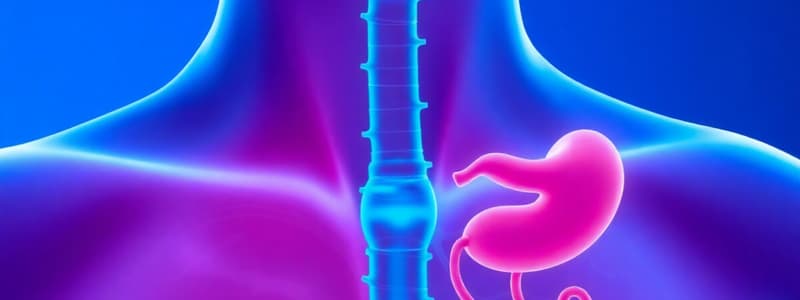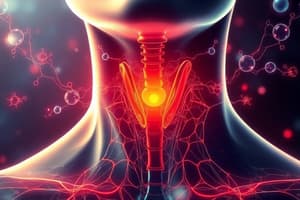Podcast
Questions and Answers
What hormone does the anterior pituitary gland release in response to Thyrotrophin-releasing hormone (TRH)?
What hormone does the anterior pituitary gland release in response to Thyrotrophin-releasing hormone (TRH)?
- Growth hormone (GH)
- Thyroid-stimulating hormone (TSH) (correct)
- Adrenocorticotropic hormone (ACTH)
- Luteinizing hormone (LH)
Which structure is anterior to the trachea and has a butterfly shape?
Which structure is anterior to the trachea and has a butterfly shape?
- Parathyroid gland
- Anterior pituitary
- Thyroid gland (correct)
- Thymus gland
What role does iodine play in the function of the thyroid gland?
What role does iodine play in the function of the thyroid gland?
- It regulates blood supply to the thyroid
- It stores calcitonin
- It promotes the secretion of growth hormone
- It is essential for the synthesis of thyroid hormones (correct)
Which of the following hormones is regulated by the anterior pituitary gland?
Which of the following hormones is regulated by the anterior pituitary gland?
Which peptide hormones are released from the hypothalamus to influence the anterior pituitary?
Which peptide hormones are released from the hypothalamus to influence the anterior pituitary?
What hormone is primarily responsible for regulating blood volume?
What hormone is primarily responsible for regulating blood volume?
Which physiological process is stimulated by thyroid hormones?
Which physiological process is stimulated by thyroid hormones?
What is the primary function of the parathyroid glands?
What is the primary function of the parathyroid glands?
Which type of hormone is produced by the adrenal medulla?
Which type of hormone is produced by the adrenal medulla?
What regulates the secretion of hormones from the adrenal cortex?
What regulates the secretion of hormones from the adrenal cortex?
Which hormone is secreted by the alpha cells in the pancreatic islet?
Which hormone is secreted by the alpha cells in the pancreatic islet?
Which condition is associated with the pituitary gland due to excess secretion of growth hormone?
Which condition is associated with the pituitary gland due to excess secretion of growth hormone?
What is the primary function of somatostatin secreted by delta cells in the pancreas?
What is the primary function of somatostatin secreted by delta cells in the pancreas?
Which hormone is primarily elevated in Graves disease, associated with thyroid dysfunction?
Which hormone is primarily elevated in Graves disease, associated with thyroid dysfunction?
Which endocrine gland is involved in diabetes mellitus due to insufficient insulin production?
Which endocrine gland is involved in diabetes mellitus due to insufficient insulin production?
What are the primary hormones secreted by the pancreatic islet's alpha and beta cells?
What are the primary hormones secreted by the pancreatic islet's alpha and beta cells?
Which conditions are associated with adrenal gland dysfunction?
Which conditions are associated with adrenal gland dysfunction?
What is the function of somatostatin secreted by delta cells in the pancreas?
What is the function of somatostatin secreted by delta cells in the pancreas?
How does Conns disease affect the adrenal glands?
How does Conns disease affect the adrenal glands?
What is the relationship between diabetes and the pancreas?
What is the relationship between diabetes and the pancreas?
How does the thyroid gland contribute to calcium homeostasis?
How does the thyroid gland contribute to calcium homeostasis?
What is the role of iodine in the synthesis of thyroid hormones?
What is the role of iodine in the synthesis of thyroid hormones?
Describe the relationship between the hypothalamus and the anterior pituitary in regulating thyroid function.
Describe the relationship between the hypothalamus and the anterior pituitary in regulating thyroid function.
What happens to the thyroid gland during swallowing and why?
What happens to the thyroid gland during swallowing and why?
Explain how the blood supply affects the function of the thyroid gland.
Explain how the blood supply affects the function of the thyroid gland.
What is the role of the parathyroid glands in maintaining calcium homeostasis?
What is the role of the parathyroid glands in maintaining calcium homeostasis?
Describe the impact of low T3 and T4 levels on metabolic processes in the body.
Describe the impact of low T3 and T4 levels on metabolic processes in the body.
How does adrenergic stimulation influence adrenal hormone secretion?
How does adrenergic stimulation influence adrenal hormone secretion?
What are the primary hormones produced by the adrenal cortex and their functions?
What are the primary hormones produced by the adrenal cortex and their functions?
Explain how negative feedback regulates the secretion of thyroid hormones.
Explain how negative feedback regulates the secretion of thyroid hormones.
Flashcards are hidden until you start studying
Study Notes
Thyroid Gland
- Located on the lower portion of the neck, anterior to the trachea.
- Butterfly-shaped, with two lobes (5 cm long) connected by the isthmus.
- Attached to the trachea, allowing the gland to move upward when swallowing.
- Function: Releases calcitonin (regulates calcium homeostasis), T3 and T4 (regulate metabolism of most cells), and stores iodine and thyroglobin (used for thyroid hormone synthesis).
- Regulated by the anterior pituitary gland (TSH).
- Blood supply: Superior and inferior thyroid arteries (thyroid ima artery supplies the isthmus in some people), drained by the superior and middle thyroid veins into the internal jugular vein and the inferior thyroid veins into the brachiocephalic vein.
Pancreas
- Each pancreatic islet contains four types of hormone-secreting cells:
- Alpha (α) cells (17%): Secrete glucagon, which raises blood glucose.
- Beta (β) cells (70%): Secrete insulin, which lowers blood glucose.
- Delta (δ) cells (7%): Secrete somatostatin, which inhibits both glucagon and insulin release.
- F or pp cells (remaining cells): Secrete pancreatic polypeptide, which inhibits somatostatin and digestive enzymes.
Parathyroid
- Located on the posterior surface of each lobe of the thyroid gland (total of four) and can vary in number (2-6).
- Size: 5 mm in diameter.
- Contains chief cells, oxyphil cells, and adipocytes.
- Function: Regulates calcium and phosphate homeostasis.
- Regulated by negative feedback based on calcium levels.
- Blood supply: Inferior thyroid arteries.
Adrenal Glands
- Paired retroperitoneal glands situated over the superior pole of each kidney.
- Right gland: Pyramidal shape.
- Left gland: Semi-lunar shape.
- Divided into medulla and cortex.
- Function: Secrete steroid and catecholamine hormones directly into the blood.
- Regulation:
- Adrenal cortex: Regulated by the pituitary gland (ACTH).
- Adrenal medulla: Regulated by the sympathetic nervous system.
Adrenal Cortex Hormones
- Glucocorticoids (e.g., cortisol): Released in response to stress.
- Mineralocorticoids (e.g., aldosterone): Regulate blood volume.
- Androgens: Sex hormones.
Adrenal Medulla Hormones
- Catecholamines: Adrenaline and noradrenaline.
Adrenal Gland Blood Supply
- Superior adrenal artery: Arises from the inferior phrenic artery.
- Middle adrenal artery: Arises from the abdominal aorta.
- Inferior adrenal artery: Arises from the renal arteries.
- Right and left adrenal veins drain the glands.
Thyroid Disorders
- TSH high, T3 low, T4 low: Hypothyroidism (low T3 and T4 due to disease, cold, pregnancy, low t3 t4, or adrenaline).
- TSH low, T3 high, T4 high: Graves disease (autoimmune, raised T3 and T4).
Hypothalamus and Pituitary Gland
- Hypothalamus releases hormones that regulate the pituitary gland
- Anterior pituitary releases TSH, GH, ACTH, LH, FSH, PRL
- Posterior pituitary releases ADH and oxytocin
Thyroid Gland
- Located anterior to the trachea, butterfly-shaped, two lobes connected by isthmus
- Function: releases calcitonin (calcium homeostasis) and thyroid hormones T3 & T4 (regulate metabolism)
- Thyroid hormones require iodine and thyroglobulin for synthesis
- Regulated by anterior pituitary gland (TSH)
- Blood supply: superior and inferior thyroid arteries, drained by superior and middle thyroid veins into the internal jugular vein, inferior thyroid veins into the brachiocephalic vein
Pancreatic Islets
- Alpha (α) cells: secrete glucagon (raises blood glucose)
- Beta (β) cells: secrete insulin (lowers blood glucose)
- Delta (δ) cells: secrete somatostatin (inhibits glucagon and insulin release)
- F cells: secrete pancreatic polypeptide (inhibits somatostatin and digestive enzymes)
Endocrine Disorders
- Addison's disease: Adrenal insufficiency
- Hypothyroidism: Thyroid gland, low T3 and T4
- Cushing's disease: Adrenal gland, raised cortisol (or too much steroid medication)
- Diabetes: Pancreas
- Conn's disease: Adrenal gland, too much aldosterone
- Grave's disease: Thyroid gland, autoimmune, raised T3 and T4
- Acromegaly: Pituitary gland, too much growth hormone
Thyroid Hormone Functions
- Increase basal metabolic rate
- Increase body temperature (calorigenic effect)
- Increase use of glucose and fatty acids
- Stimulate lipolysis
- Regulate development and growth of nervous tissue and bones
Parathyroid Gland
- Located on the posterior surface of each lobe of the thyroid gland (total 4)
- Structure: 5mm in diameter, chief cells, oxyphil cells, and adipocytes
- Function: calcium and phosphate homeostasis
- Regulated by negative feedback, calcium levels
- Blood supply: inferior thyroid arteries
Adrenal Glands
- Paired retroperitoneal glands situated over the superior pole of each kidney
- Right gland is pyramidal, left gland is semi-lunar
- Separated into medulla and cortex
- Secrete steroid and catecholamine hormones directly into blood
- Adrenal cortex regulated by pituitary gland (ACTH), adrenal medulla regulated by sympathetic nervous system
Adrenal Cortex
- Glucocorticoids: in response to stress (cortisol)
- Mineralocorticoids: regulate blood volume (aldosterone)
- Androgens: sex hormone
Adrenal Medulla
- Catecholamines: adrenaline and noradrenaline
Adrenal Blood Supply
- Superior adrenal artery: arises from inferior phrenic artery
- Middle adrenal artery: arises from abdominal aorta
- Inferior adrenal artery: arises from renal arteries
- Right and left adrenal veins drain the glands
Studying That Suits You
Use AI to generate personalized quizzes and flashcards to suit your learning preferences.




